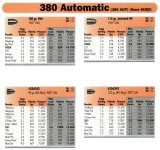A simple point to consider:
Cast lead bullets, even those made of the harder alloys, are significantly softer than any jacketed bullet. They are accelerated more easily and develop much less friction in the bore, so both the maximum pressures and the pressure impulse curve are lower than any jacketed bullet (assuming the same load and firearm).
That said, those qualities come with some limitations. Powder selections (burning rates, charge levels, etc) must remain within the appropriate range to avoid some of the problems that jacketed bullets were developed to overcome (leading of the lands & grooves, excessive expansion of the bullet under initial pressure, melting of the bullet base caused by flame temperatures of the burning powder, etc).
Also, some firearms can cause problems with exposed lead bullets due to designs of the feeding mechanism (another obstacle that jacketed bullets provide some advantages for).
I've been casting bullets for 48 years and use cast bullets almost exclusively in most of my firearms. We just have to understand the strengths and weaknesses and work within the range of real possibilities.
The Lyman cast bullet manuals are an excellent starting point for anyone considering this.

